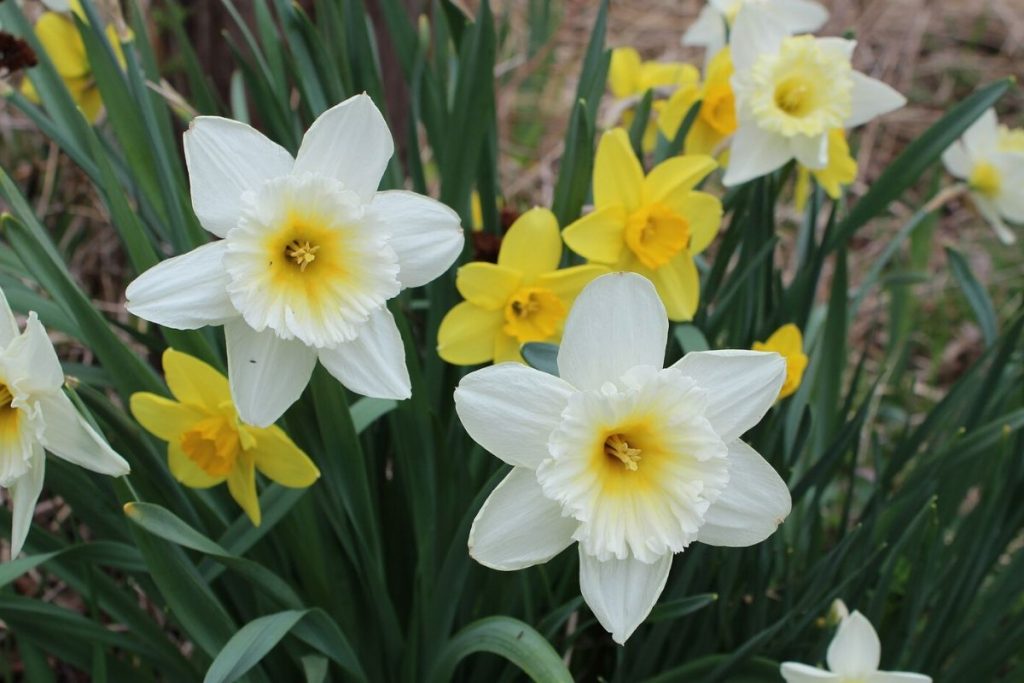One can never really go wrong with daffodils or Narcissus spp. Renowned for their beautiful bright yellow or white blooms, this flowering perennial is one of the first plants to bring colors in gardens and often indicates the onset of springtime.
Daffodils are popular seasonal flowers, but do you know how to grow one properly? Do you know how to care for these attractive blooms? We’ve made a quick guide on everything about daffodils.
Learn about this spring-favorite plant’s origin and meaning, planting tips, care and maintenance, and some of its most popular varieties by reading below.
Plant Name and Origin

Daffodil is a common name that refers to the flowering plants under the entire Narcissus genus in the Amaryllidaceae family. Because of this, daffodils are also referred to as narcissus. Other known common names of these spring flowering plants are daffadowndilly and jonquil.
In England, daffodils are called lent lilies. While it is often used as a generic name for daffodils, it speaks specifically of Narcissus pseudonarcissus, a wild daffodil that flowers and dies away between Ash Wednesday and Easter Sunday; hence the name lent lily.
The genus name Narcissus comes from the Greek mythological character Narcissus who is known for admiring his own beauty (1).
Narcissus is a hunter and son of Cephissus, the river god. The legend says that he refused to leave the stream when he fell in love with his reflection on the water. When he succumbed to death, the gods turned him into a flower so he could stay there forever.
Daffodil Uses
Daffodils surely add colors in every garden, large or small. These plants give out fascinating blooms that make any landscape beyond impressive. They can be mass planted under ground covers, or mixed with shrubs and other perennials (2).
Beautify steep areas in your garden by mass planting daffodils as design accents and using timbers for soil erosion control. They also work well as an edging ornamental plant in landscaping or mixed borders. Daffodils in pots are also popular as indoor ornamentals.
Plant Description
Daffodils are clumping and erect perennials that grow from bulbs. Generally, they grow about 1 to 2 feet and spread up to 0.5 to 2 feet upon full maturity (3).
Leaves
Most of the leaves emerge from the soil, usually without a stem. The individual leaf is simple, linear with parallel venation, and grows about 12 to 18 inches (3).
Flowers
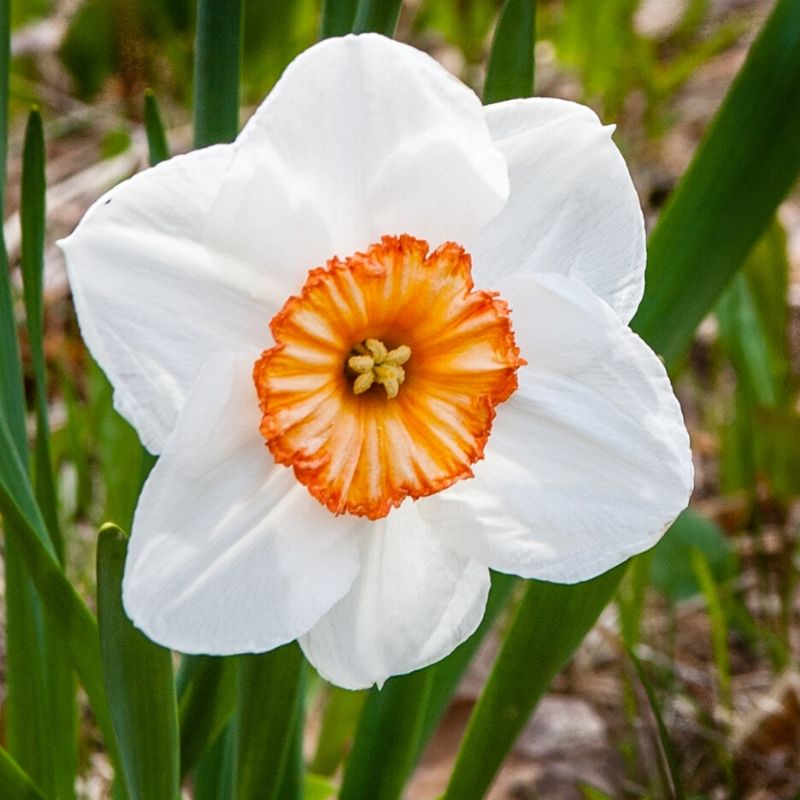
The colors of daffodil flowers vary depending on the variety and range from yellow to pink, white, or variegated.
Flowers appear singly or in a cluster on top of a naked, long, and narrow stem. Each daffodils flower has a central tubular-like corona trumpet or cup, three petals, and petal-shaped sepals. In some varieties where the corona is longer than the petals, it is referred to as trumpet; and if it is shorter, it is called a cup (4).
What Are The Popular Daffodil Cultivars?
Daffodils or Narcissus are long-lived perennials that offer an enticing array of flowers in different forms, sizes, and colors.
The entire Narcissus genus has at least 25 species and thousands of cultivated varieties. Below are some of the most popular Narcissus cultivars across the globe.
Narcissus ‘Dutch Master’
One of the most famous trumpet daffodils is the Narcissus ‘Dutch Master’ or otherwise called Dutch Master daffodils.
This crowd-favorite cultivar produces golden-yellow blooms with oversized trumpets. An award-winning daffodil, the Dutch Master is famed for its early flowering and its ability to naturalize well in a landscape.
Narcissus ‘Mount Hood’
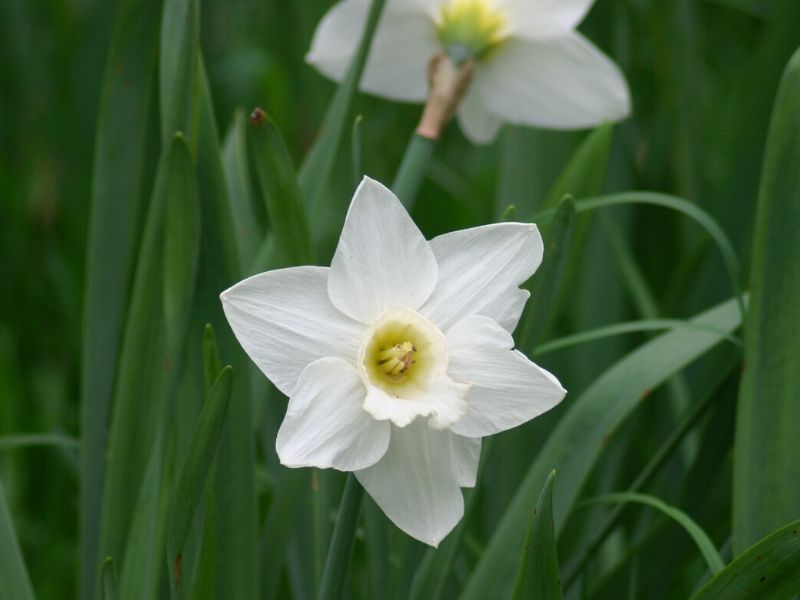
Narcissus ‘Mount Hood’ is another famed trumpet daffodil. It reaches about 1 to 1.5 feet in height and spreads up to 0.75 feet.
Unlike the ‘Dutch Master,’ this cultivar is known for its showy ivory white blooms that grow singly on a stem. The leaves are green, narrow, and strap-shaped.
Narcissus ‘Tahiti’
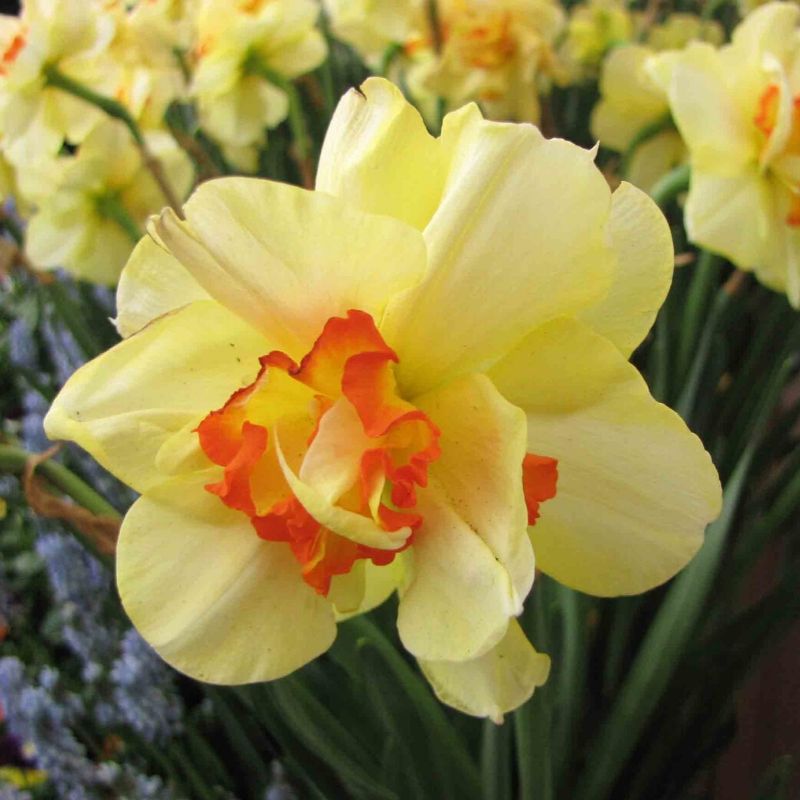
Narcissus ‘Tahiti’ is a multiple award-winning double daffodil cultivar. It features large, double flowers with layers of golden yellow petals with red-orange accents around the center.
This cultivar gives out long-lasting flowers that are mid to late spring bloomers. Each plant grows about 16 inches tall.
Narcissus ‘Golden Echo’
Long-lasting ‘Golden Echo’ daffodil is an American hybrid that features white petals with a golden yellow halo around the base and lemon yellow trumpets.
The flowers, which measure about 3 inches across, are fragrant. Narcissus ‘Golden Echo’ plants are ideal for beds and borders.
Narcissus ‘Tete a Tete’
‘Tete a Tete’ narcissus is one of the most recognized miniature daffodils. Its fragrant daffodils bloom in early to mid-spring. Each stem carries 1 to 3 buttercup yellow flowers and grows about 6 to 8 inches in height.
Best planted in groups of at least six bulbs, ‘Tete a Tete’ works best in flower beds, landscaping, and containers.
Narcissus ‘Tete a Tete’ is classified as part of daffodils’ division 12 (miscellaneous daffodils) group.
Narcissus ‘Peeping Tom’
This one-of-a-kind dwarf daffodil features prominent, long, frilled trumpet that’s surrounded by reflexed vivid yellow petals and sepals. The ‘Peeping Tom’ daffodils are long-lived and vigorous. They grow about 8 to 12 inches in height. Flowering commences in early spring.
This daffodil falls under the cyclamineus narcissus (Division VI) group.
Narcissus ‘Barrett Browning’
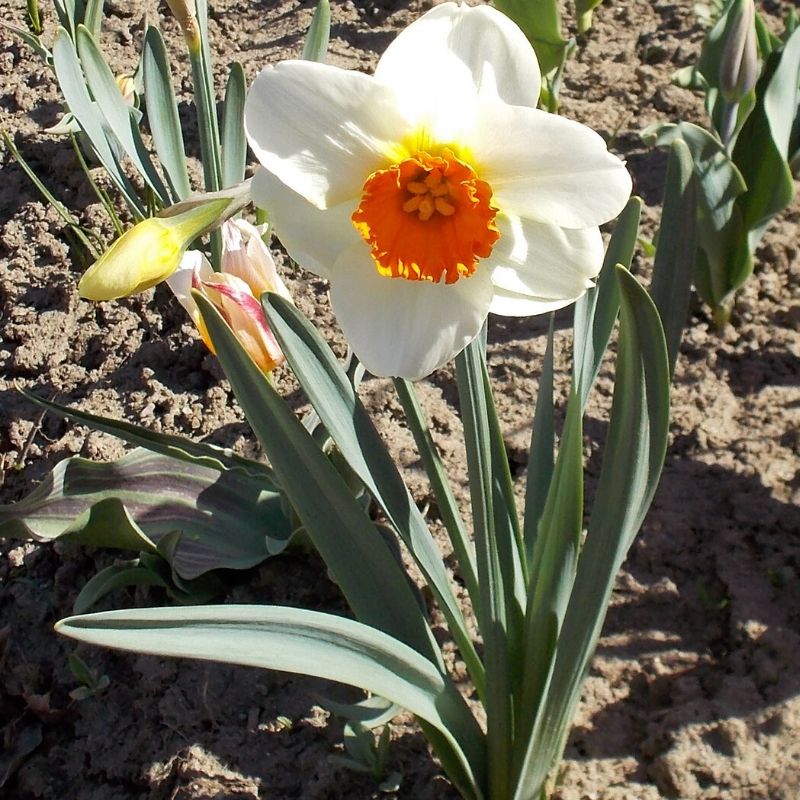
With their pure white, overlapping petals surrounding a distinctive red-orange cup with a yellow halo at the base, it would be difficult not to recognize the Narcissus ‘Barrett Browning’.
This plant grows about 30 to 60 cm and spreads 5 to 7 cm. It blooms in mid-spring with one flower per stem.
Narcissus ‘Jack Snipe’
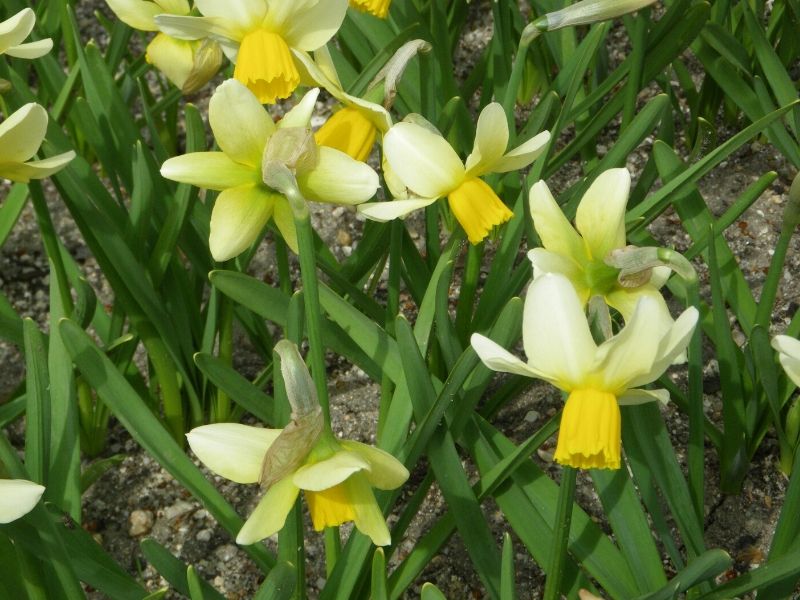
The ‘Jack Snipe’ Narcissus flaunts an attractive and fragrant creamy-white and yellow blooms.
This miniature trumpet daffodil is part of the cyclamineus narcissus group and grows up to 8 to 10 inches tall. Typically, it blooms for six weeks in early to mid-spring.
Narcissus ‘Pink Pride’
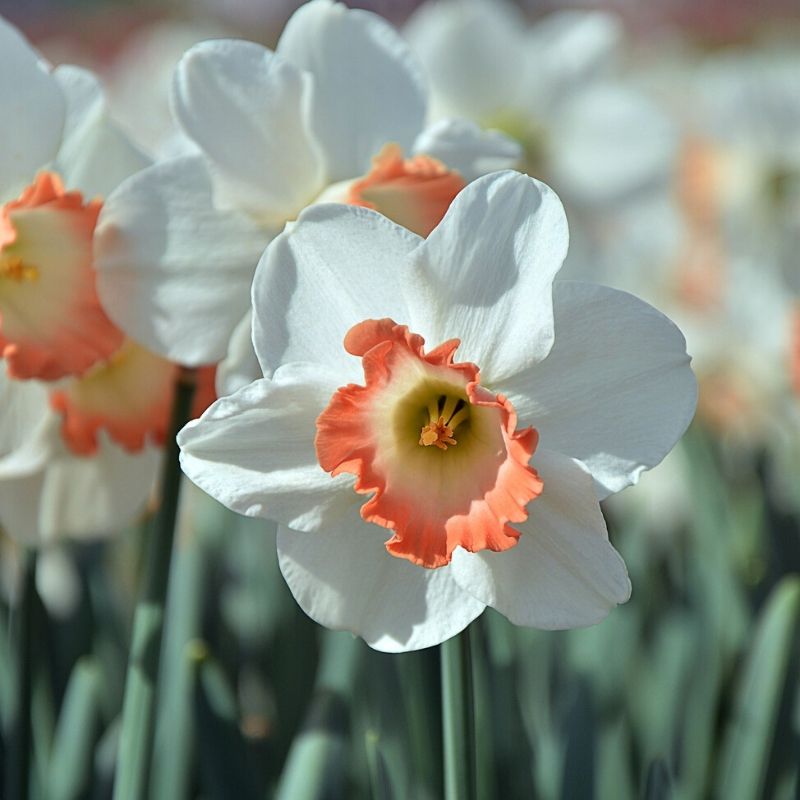
This showy daffodil flaunts large blooms with ivory white petals and apricot cup that gradually changes to coral pink as it matures.
It reaches up to 16 inches tall, and flowers bloom in mid-spring. Narcissus ‘Pink Pride’ is part of the large-cup narcissus group.
Narcissus ‘Goblet’
Narcissus ‘Goblet’ displays long-lasting, attractive blooms with a ruffled golden yellow trumpet and overlapping pure white petals. A golden yellow halo at the base of the trumpet gives an added flair to the blossoms.
The trumpet fades to lemon yellow as the flowers mature. The plant grows up to 16 to 18 inches in height and blooms in early to mid-spring.
How to grow Daffodils
Daffodils are herbaceous perennials native to northern Europe. One of the reasons for their popularity is the fact that these ornamental plants are easy to grow. They thrive well in almost all zones, and the care and maintenance required to cultivate one successfully are minimal.

Propagating Daffodils
Daffodils can be propagated by bulb division or seeds (1). They thrive best in fertile, well-drained, slightly acidic soil, as poor soil drainage may cause the bulbs to rot. They flower best when planted in full sun or partial shade, but the blooms last longer in light shade (3).
Seeds
Growing daffodils from seeds takes a longer time, but this does not hinder growers from doing this method.
Once the bees have pollinated the flowers, wait for seed pods to grow and mark them for later use. You can harvest daffodil seeds from these pods when the plants turn brown in the fall. Harvestable seeds rattle in the pods when shaken.
Sow daffodil seeds in a seed tray with equal parts of potting soil, perlite, and peat moss. Keep the soil moist while the daffodil seeds germinate by daily misting and make sure that the seed tray is exposed to at least six hours of direct sunlight. It would take several weeks for the seeds to sprout.
Replant daffodil seedlings in larger pots that would give enough space for the bulbs to grow. When young daffodil plants reach maturity, which usually takes three to five years, you can transplant them in their permanent location or flowerbeds in your garden.
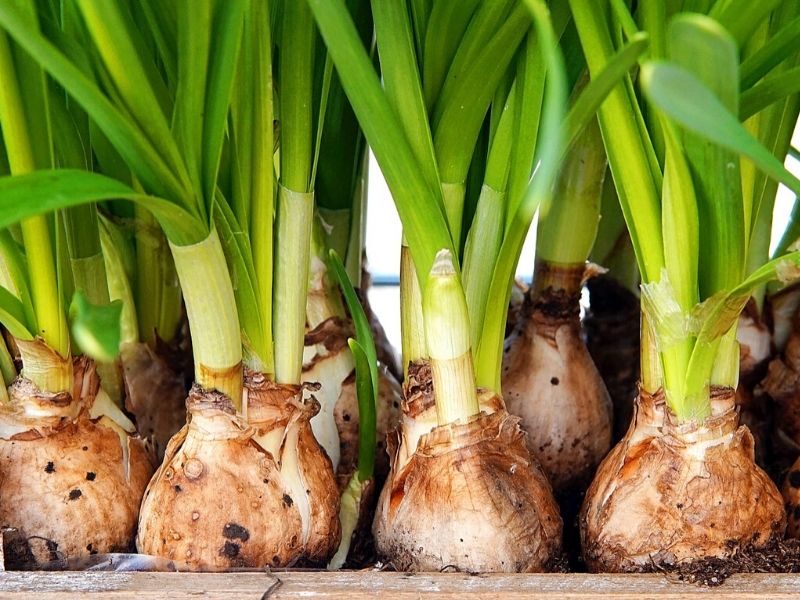
Bulb Division
Daffodil bulbs require cold temperatures, preferably about 60 to 65 degrees Fahrenheit, to promote root development. Thus, they should be planted in the fall before the first frost or about 2 to 4 weeks before the ground freezes.
Planting Daffodil bulbs four to five inches below the ground and covering them with sufficient soil. The distance between bulbs should be eight inches. Each spring, apply a slow-release bulb fertilizer to pots.
How to Care for Daffodils
If you have no plans on harvesting seeds from your daffodil plants, deadheading can be made as soon as the flowers fade. However, you should avoid cutting down the leaves for at least six more weeks.
Instead, allow the leaves to mature and die off naturally because the plants need time after flowering to store energy in the bulbs for the next season. Prematurely cutting the leaves may reduce subsequent flowering.
Over time, daffodil plants may bloom smaller and have fewer flowers. When this happens, you can divide the clumps of bulbs once the leaves have died down and replant individual bulbs.
Pests and Diseases
Some of the most common pests of daffodils are tulip bulb aphids, bulb mites, bulb flies, millipedes, and stem and bulb nematodes (3). These pests feed on plant parts, mostly the bulbs and leaves.
Common diseases of daffodils include armillaria root rot, bacterial streak, soft rot, Fusarium wilt, gray mold, dry rot, gray bulb rot, and viruses like Narcissus white streak virus and Narcissus yellow stripe virus (5).
When selecting daffodil companion plants, you need to make sure that these plants won’t carry the potential pets or diseases that can harm your daffodils.
Toxicity
Narcissus spp. contains poisonous substances that can be harmful to pets and young kids. The bulbs, in particular, have oxalate crystals and alkaloids such as lycorine and scillitoxin.
When ingested in large amounts, daffodil bulbs may cause severe vomiting, diarrhea, drowsiness, convulsions, and mouth irritation.
The flowers, stems, and leaves can also be poisonous. Direct contact with certain plant parts of daffodils may result in contact dermatitis, known as the lily rash (6).
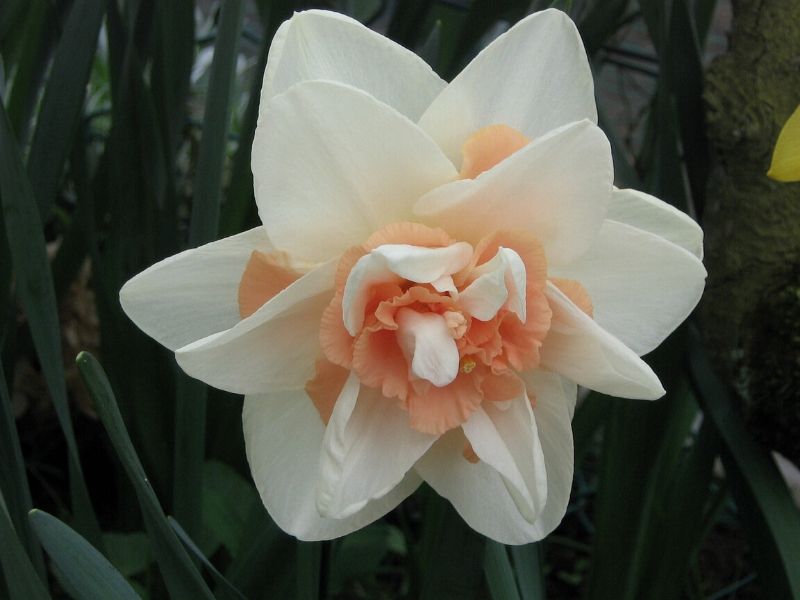
FAQs
What do I do with daffodils after flowering?
After daffodils (Narcissus) finish flowering, leave the foliage intact until it turns yellow and withers. This allows the bulbs to replenish nutrients for the next season.
Why are my daffodils dying?
Daffodils may die prematurely due to inadequate sunlight, poor soil drainage, or diseases. Ensuring plant daffodils are in well-draining soil, receive sufficient sunlight, and avoid overwatering can help address these issues.
What climate do daffodils grow best in?
Daffodils grow best in temperate climates with a cold winter period. They thrive in USDA hardiness zones 3 to 8. These plant bulbs require winter chilling to produce blooms in spring.
Up next: Daffodil Flower Meaning and Symbolism
References
Reference list
(1) Ndsu.edu. (2019). Daffodils. [online] Available at: https://www.ndsu.edu/pubweb/chiwonlee/plsc211/student%20papers/articles00/rkraft/daffodil.htm
(2) Hort.ufl.edu. (2019). [online] Available at: http://hort.ufl.edu/database/documents/pdf/shrub_fact_sheets/narsppa.pdf
(3) Gilman, E. Narcissus spp. Daffodil, Narcissus. [online] Available at: https://edis.ifas.ufl.edu/pdffiles/FP/FP42300.pdf
(4) Daffodils, S. (2019). Spring Flowering Bulbs: Daffodils. [online] Extension2.missouri.edu. Available at: https://extension2.missouri.edu/g6610
(5) Ipm.ucanr.edu. (2019). Managing Pests in Gardens: Floriculture: Daffodil—UC IPM. [online] Available at: http://ipm.ucanr.edu/PMG/GARDEN/FLOWERS/daffodil.html
(6) Plants.ces.ncsu.edu. (2019). Narcissus (Daffodils, Jonquils, Narcissus) | North Carolina Extension Gardener Plant Toolbox. [online] Available at: https://plants.ces.ncsu.edu/plants/narcissus/
Close

